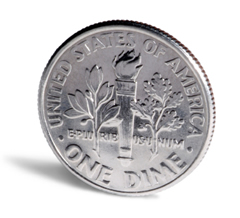Small Surprise, Big Mood Change
 What does it take to make you happy? Not much. A classic study by psychologist Norbert Schwarz found that ten cents would do the trick. He and his cohorts repeatedly placed a dime near a copy machine where they knew it would be found. When the subjects who found the dime were surveyed shortly after their discovery, their overall satisfaction with life was substantially higher than other subjects who did not find a coin.
What does it take to make you happy? Not much. A classic study by psychologist Norbert Schwarz found that ten cents would do the trick. He and his cohorts repeatedly placed a dime near a copy machine where they knew it would be found. When the subjects who found the dime were surveyed shortly after their discovery, their overall satisfaction with life was substantially higher than other subjects who did not find a coin.
While the original study was conducted back in 1987 when a dime bought more than it does today, the basic idea remains the same: even a tiny positive surprise can improve one’s outlook, albeit temporarily. In an interview with the Baltimore Sun, Schwarz noted, “It’s not the value of what you find. It’s that something positive happened to you.”
Food Works Too
The same article in the Baltimore Sun described a similar effect using a food sample: “Another study asked people leaving a grocery store to evaluate only their satisfaction with their TVs back home… Those who minutes earlier got a free sample of food from the store liked their TVs better than those who missed the sample.”
Branding Implications
While these results may be fascinating for academics who study the psychology of happiness, what are the takeways for marketers? The biggest, I think, is that one has the opportunity to create an association of improved mood with a brand if a small positive surprise can be delivered at the same time. And it doesn’t have to be a total surprise – receiving a food sample at a grocery store isn’t a shocking occurrence.
I’m sure Neuromarketing readers can come up with a host of ways to create a small, positive surprise, but here are a few that came to my mind immediately:
- Sampling, but with clear brand identity. Sampling is fairly pervasive these days in supermarkets and wholesale stores, but often the brand identity is lost in the shuffle. Sampling in a venue not already flooded with sampling stations, ensuring that the display shows the brand, and training the attendant to mention the brand by name would do the trick.
- Surprise in the box. Product makers could include a small, inexpensive free accessory or promotional item in the product package. Obviously, putting “free ___ inside!” on the outside of the box would kill any surprise. But, calling the item a “free gift” inside the box would emphasize that it is of some value or utility and likely enhance the surprise.
Have YOU found a way to surprise your customers?
Creepy Footnote: I was researching this article at Starbucks, and was amused to see the Sun article include the comment, “Amazing how a mouthful of free lemon pound cake can improve your life…” Literally minutes before reading that eleven-year old article, the Starbucks barista had surprised ME by giving me a slice of, you guessed it, LEMON POUND CAKE. (Apparently, the cake was actually a gift of an earlier patron who wanted to treat fellow coffee lovers, rather than a targeted mood-enhancement by Starbucks neuromarketing wizards.)
